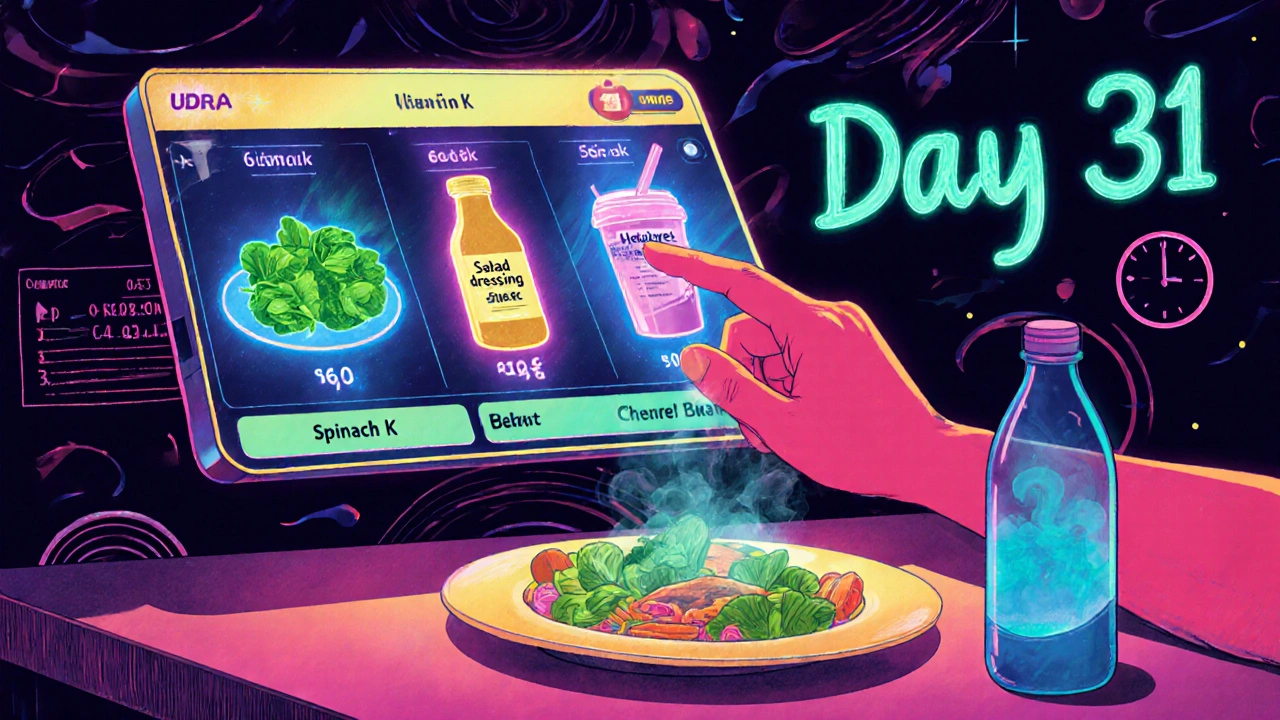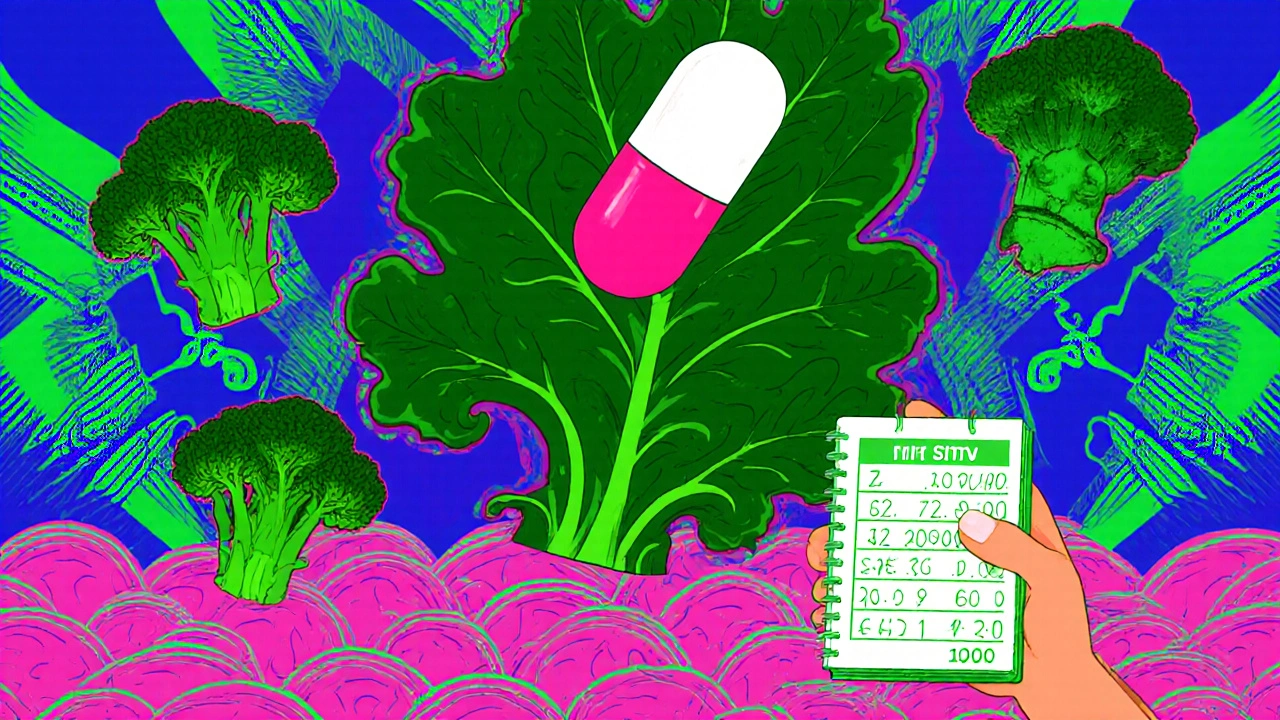Vitamin K Intake Tracker
Track Your Vitamin K Intake
Monitor your vitamin K consumption to maintain stable INR levels. Consistent intake is key—aim for the same amount each day.
For warfarin patients: Aiming for 150-200 mcg daily is generally recommended for consistency, but your ideal range may vary. Always consult your doctor.
Your Daily Intake
Note: This tool estimates vitamin K based on USDA data. It's not a replacement for medical advice. Always consult your healthcare provider for your individual needs.
Why Your Warfarin Dose Depends on What You Eat
If you’re on warfarin, your blood thinner isn’t just reacting to your dose-it’s reacting to your dinner. Warfarin works by blocking vitamin K, a nutrient your body needs to make blood clot. Too much vitamin K? Your INR drops, and you’re at risk for dangerous clots. Too little? Your INR spikes, and you could bleed internally without warning. The difference between safety and crisis often comes down to consistency-not avoidance.
Most people think they need to stop eating spinach or broccoli. That’s wrong. You don’t have to cut out vitamin K. You just have to keep it steady. One day, you eat a big salad. The next, you skip it. Your INR swings. Your doctor adjusts your dose. You feel fine-until the next fluctuation. This cycle is why so many warfarin patients end up in the emergency room. According to the FDA, inconsistent vitamin K intake causes over a third of all warfarin-related ER visits.
What Exactly Is Vitamin K, and Where Is It Hiding?
Vitamin K comes in two main forms: K1 (phylloquinone) from plants, and K2 (menaquinones) from animal and fermented foods. For warfarin users, K1 is the big concern. It’s in green leafy vegetables, cruciferous veggies, and certain oils.
- Cooked kale: 817 mcg per 100g
- Cooked spinach: 483 mcg per 100g
- Cooked broccoli: 220 mcg per 100g
- Raw romaine lettuce: 138 mcg per 100g
- Soybean oil: 180 mcg per tablespoon
- Ensure nutrition shake: 25 mcg per 8 oz
One cup of cooked spinach has more vitamin K than the entire daily recommended intake for a healthy adult. That’s not a problem if you eat it every day. But if you eat it once a week, your body reacts like a switch flipped. Your INR jumps. Your warfarin dose gets changed. And you’re back to guessing what’s safe.
How a Food Diary Stops the INR Rollercoaster
A food diary isn’t about counting calories or losing weight. It’s about tracking vitamin K intake so your doctor can predict how your body will respond to your dose. The goal isn’t to eat zero vitamin K. It’s to eat the same amount, roughly, every day.
Studies show that patients who keep a food diary for just 30 days improve their time in therapeutic range (TTR) by 8-10 percentage points. That means fewer dose changes, fewer blood tests, and less risk of bleeding or clotting. In one 2022 trial with 327 patients, those using a digital food diary stayed in their target INR range 72% of the time. Those using paper logs? Only 62%.
Here’s what a good food diary tracks:
- Date
- Food eaten (specifics matter: "spinach" isn’t enough-"1 cup cooked spinach" is)
- Portion size (use your hand or a measuring cup)
- Estimated vitamin K content
- Your INR value from that day’s blood test
Don’t guess. Write it down. Even if you think it’s "just a salad." That’s exactly when mistakes happen.

Paper vs. Digital: Which Food Diary Works Better?
You can use a notebook, a printable template, or a phone app. Both work-but they have trade-offs.
Paper diaries are simple. No learning curve. No battery. Great for older adults or those who don’t use smartphones. The Veterans Health Administration still uses them in 43% of clinics. But they’re easy to lose, smudge, or forget. One patient lost two weeks of data when his diary got wet in his pocket.
Digital apps are more accurate and more convenient. The Vitamin K Counter & Tracker app (iOS, $2.99 one-time fee) has over 1,200 foods with data pulled from the USDA database. It shows you daily vitamin K totals in real time. Users report fewer INR swings and less anxiety about their diet. In 2021, a University of Toronto study found this app was 94.7% accurate compared to lab-tested food samples.
But not all apps are created equal. A 2023 review found 68% of vitamin K apps have no clinical validation. Some free apps mislabel foods by 30% or more. Stick to apps with published accuracy data. Avoid general nutrition trackers like MyFitnessPal-they’re designed for calories, not vitamin K. They’re 3.2 times less accurate for warfarin users.
The Hidden Traps No One Tells You About
Most people track the obvious: kale, spinach, broccoli. But the real trouble comes from the hidden sources.
- Soybean oil in salad dressings, fried foods, and baked goods
- Canola oil in packaged snacks
- Multivitamins with vitamin K (25-100 mcg per pill)
- Fortified meal replacements like Ensure
- Processed foods with "vegetable oil" on the label
A 2020 NIH study found patients underreported vitamin K intake by 22-37%. Why? They didn’t realize how much was in their lunch sandwich or their protein bar. One woman took her warfarin daily and ate the same salad every day-until she switched salad brands. The new dressing had soybean oil. Her INR dropped. She didn’t connect the dots until she had a minor stroke.
Portion size is another trap. A "handful" of spinach isn’t a cup. A "dollop" of oil isn’t a teaspoon. Use measuring spoons and cups for the first few weeks. Then learn to eyeball it. Visual portion guides from your clinic can cut estimation errors by 41%.

What Experts Really Say About Diet and Warfarin
Dr. Gary Raskob, lead author of the 2021 American Society of Hematology guidelines, puts it bluntly: "The most important advice for patients on warfarin is to maintain their usual dietary pattern and report any planned changes."
It’s not about going vegan or eating only chicken. It’s about consistency. One study showed patients who ate exactly 150 mcg of vitamin K every day had 18% fewer INR fluctuations than those who ate variable amounts averaging 150 mcg. The average didn’t matter. The consistency did.
The American Heart Association gives dietary tracking a "Class I" recommendation-the highest level of evidence. That means it’s not optional. It’s standard care.
And here’s the kicker: even if you’re on a stable dose, your diet still matters. Many patients think once they’ve found the right warfarin dose, they’re done. But vitamin K changes your body’s response. Your dose isn’t fixed-it’s dynamic. Your food diary is your early warning system.
How to Start a Food Diary That Actually Works
Follow this 3-step plan:
- Orientation (Day 1): Talk to your anticoagulation clinic or pharmacist. Get a printed template or download a validated app. Ask for a list of high-vitamin K foods and portion examples.
- Active Tracking (Days 2-30): Log everything you eat and drink. Include sauces, oils, supplements, and drinks. Don’t skip meals. Don’t guess. Write it down immediately after eating. Take a photo if you need to remember later.
- Maintenance (Day 31 onward): Review your log with your doctor every month. Look for patterns. Did your INR drop after you started eating more broccoli? Did it spike after you switched to a new brand of salad dressing? Adjust your habits, not just your dose.
Many clinics offer a 15-20 minute training session. Don’t skip it. At VA hospitals, patients needed two visits just to learn how to use the diary properly. That’s how much detail matters.
What’s Next? The Future of Food Tracking
Technology is catching up. In January 2024, the FDA approved the first AI-powered food tracker, NutriKare, that uses your phone camera to estimate vitamin K content from photos. It’s 89% accurate in trials.
Hospitals like those using Epic’s MyChart system now integrate food diaries directly into your electronic health record. Your INR predictions might soon be auto-generated based on your logged meals.
But for now, the best tool is still the one you’ll use every day. Whether it’s a notebook in your purse or an app on your phone, the key is consistency-not perfection.
Don’t aim for a perfect log. Aim for a reliable one. Track your vitamin K like you track your medication: every day, without fail. Your blood will thank you.
Do I need to avoid vitamin K completely while on warfarin?
No. Avoiding vitamin K is dangerous and unnecessary. Your body needs it to function. Instead, keep your daily intake consistent. Eating the same amount of vitamin K every day helps your warfarin dose stay stable. Sudden changes-eating a lot one day and none the next-are what cause INR swings and increase your risk of clots or bleeding.
Can I use MyFitnessPal or Lose It! to track vitamin K?
Not reliably. General nutrition apps like MyFitnessPal are designed for calories and macronutrients, not vitamin K. A 2023 JAMA Internal Medicine study found they’re 3.2 times less accurate than apps built specifically for warfarin patients. Use a dedicated app like Vitamin K Counter & Tracker, which uses verified USDA data and tracks vitamin K content precisely.
What if I forget to log my food one day?
Don’t panic, but don’t ignore it. One missed day won’t ruin your progress, but it can mask a pattern. If you miss a day, estimate what you ate based on your usual meals. If you’re unsure, note "unknown" and mention it at your next appointment. Consistency over time matters more than perfection in every log.
How long should I keep a food diary?
For as long as you’re on warfarin. Even if your INR is stable, your diet can change-new foods, different restaurants, seasonal produce, or new supplements. A food diary isn’t a temporary fix. It’s a lifelong safety tool. Many patients stop logging after a few months and end up back in the doctor’s office with an unstable INR.
Can my doctor adjust my warfarin dose just from my food diary?
Not alone. Your INR blood test is still the gold standard. But your food diary tells your doctor why your INR changed. If your INR dropped after you ate more kale, your doctor can adjust your dose and advise you to reduce portions-not just change your pill count blindly. The diary turns guesswork into informed decisions.
Are there free alternatives to paid vitamin K apps?
Yes, but be careful. Some free apps lack accuracy or clinical validation. Your clinic may offer a free printable food diary template. You can also use the USDA FoodData Central website to look up vitamin K content manually. But if you want real-time tracking, reliable data, and visual feedback, the $2.99 Vitamin K Counter & Tracker app is worth the cost. It’s been validated by multiple studies and used by thousands of patients successfully.

Rachael Gallagher
November 25, 2025 AT 01:02steven patiño palacio
November 26, 2025 AT 23:29akhilesh jha
November 27, 2025 AT 07:38Jeff Hicken
November 27, 2025 AT 18:35Nikki C
November 28, 2025 AT 09:09Alex Dubrovin
November 29, 2025 AT 05:57Jacob McConaghy
November 29, 2025 AT 17:58Natashia Luu
November 30, 2025 AT 07:04